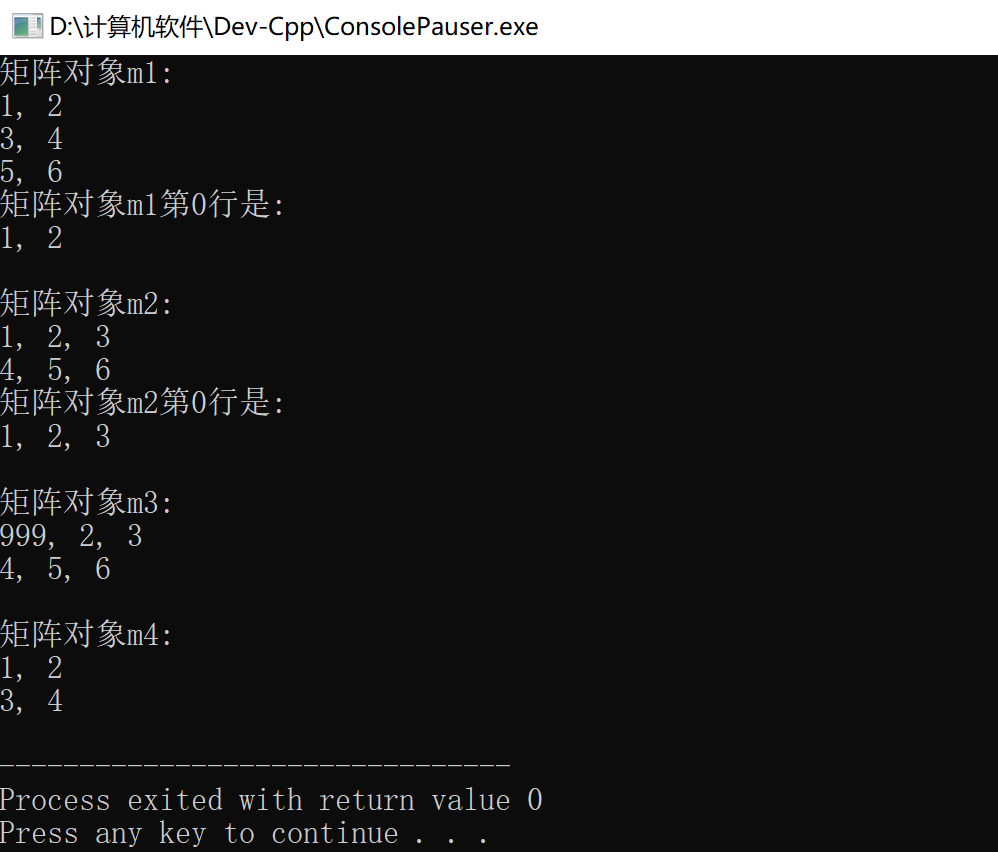#pragma once
#include <iostream>
using std::cout;
using std::endl;
class Point {
public:
Point(int x0 = 0, int y0 = 0);
~Point() = default;
int get_x() const;
int get_y() const;
void show() const;
void move(int new_x, int new_y);
private:
int x, y;
};
Point::Point(int x0, int y0): x{x0}, y{y0} {
}
int Point::get_x() const {
return x;
}
int Point::get_y() const {
return y;
}
void Point::show() const {
cout << "(" << x << ", " << y << ")" << endl;
}
void Point::move(int new_x, int new_y) {
x = new_x;
y = new_y;
}
#include <iostream>
#include "point.hpp"
#include <vector>
using std::vector;
using std::cin;
// 输出vector<Point>对象内所有点的坐标
void output(const vector<Point> &v) {
for(auto &t: v)
t.show();
}
void test() {
int n;
cin >> n;
vector<Point> x(n);
cout << "x对象中所有点坐标信息: " << endl;
output(x);
vector<Point> y(x);
cout << "\nx对象中所有点坐标信息: " << endl;
output(y);
cout << "\n更新x对象: " << endl;
x.at(0).move(30, 50);
x.push_back(Point(2, 2));
cout << "\nx对象中所有点坐标信息: " << endl;
output(x);
cout << "\ny对象中所有点坐标信息: " << endl;
output(y);
}
int main() {
test();
}
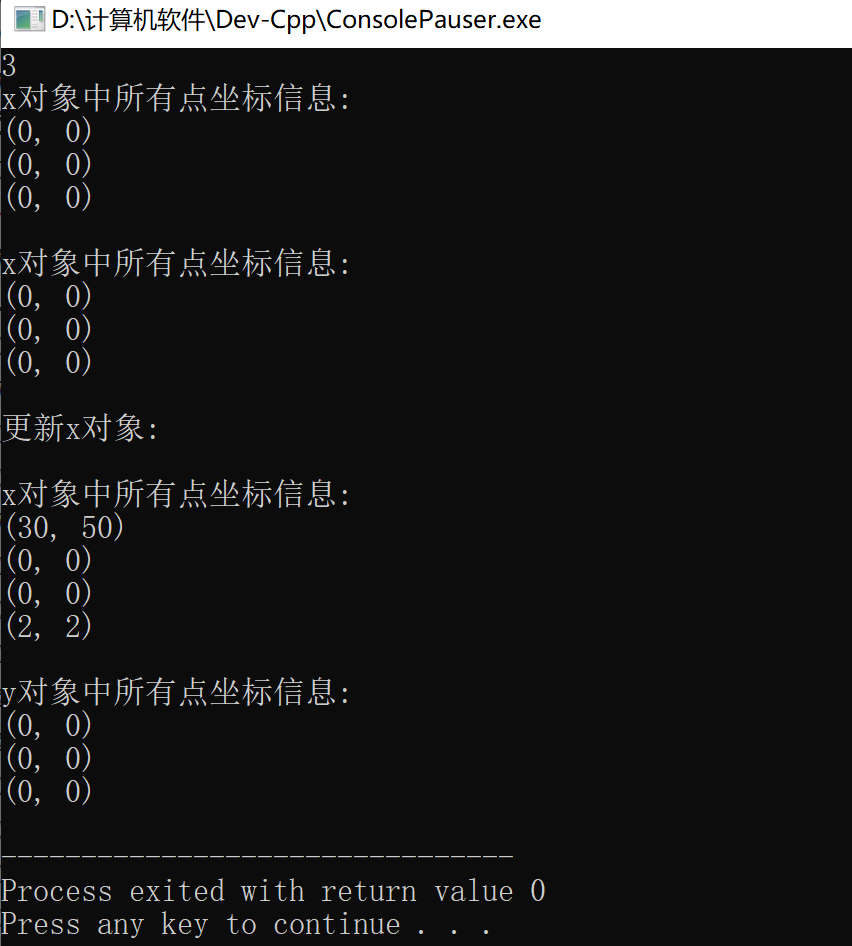
#pragma once
#include <iostream>
using std::cout;
using std::endl;
class Point {
public:
Point(int x0 = 0, int y0 = 0);
~Point() = default;
int get_x() const;
int get_y() const;
void show() const;
void move(int new_x, int new_y);
private:
int x, y;
};
Point::Point(int x0, int y0): x{x0}, y{y0} {
}
int Point::get_x() const {
return x;
}
int Point::get_y() const {
return y;
}
void Point::show() const {
cout << "(" << x << ", " << y << ")" << endl;
}
void Point::move(int new_x, int new_y) {
x = new_x;
y = new_y;
}
#pragma once
#include "point.hpp"
#include <cassert>
#include <iostream>
class vectorPoint{
public:
vectorPoint(int n);
~vectorPoint();
int get_size() const;
Point &at(int index);
Point& at(int index) const;
private:
int size;
Point* ptr;
};
vectorPoint::vectorPoint(int n):size{n}
{
ptr=new Point[n];
}
vectorPoint::~vectorPoint() {
delete[] ptr;
}
int vectorPoint::get_size() const {
return size;
}
Point& vectorPoint:: at(int index){
assert(index >= 0 && index < size);
return ptr[index];
}
Point& vectorPoint::at(int index) const {
assert(index >= 0 && index < size);
return ptr[index];
}
#include "vectorPoint.hpp"
#include <iostream>
void output(const vectorPoint &v) {
for(auto i = 0; i < v.get_size(); ++i)
v.at(i).show();
}
void test() {
using namespace std;
int n;
cout << "输入vectorPoint对象中元素个数: ";
cin >> n;
vectorPoint x(n);
cout << "x对象中所有点坐标信息: " << endl;
output(x);
vectorPoint y(x);
cout << "\ny对象中所有点坐标信息: " << endl;
output(y);
cout << "\n更新x对象中点坐标信息......" << endl;
x.at(0).move(30, 50);
x.at(1).move(-1, -1);
cout << "x对象中所有点坐标信息: " << endl;
output(x);
cout << "\ny对象中所有点坐标信息: " << endl;
output(y);
}
int main() {
test();
}
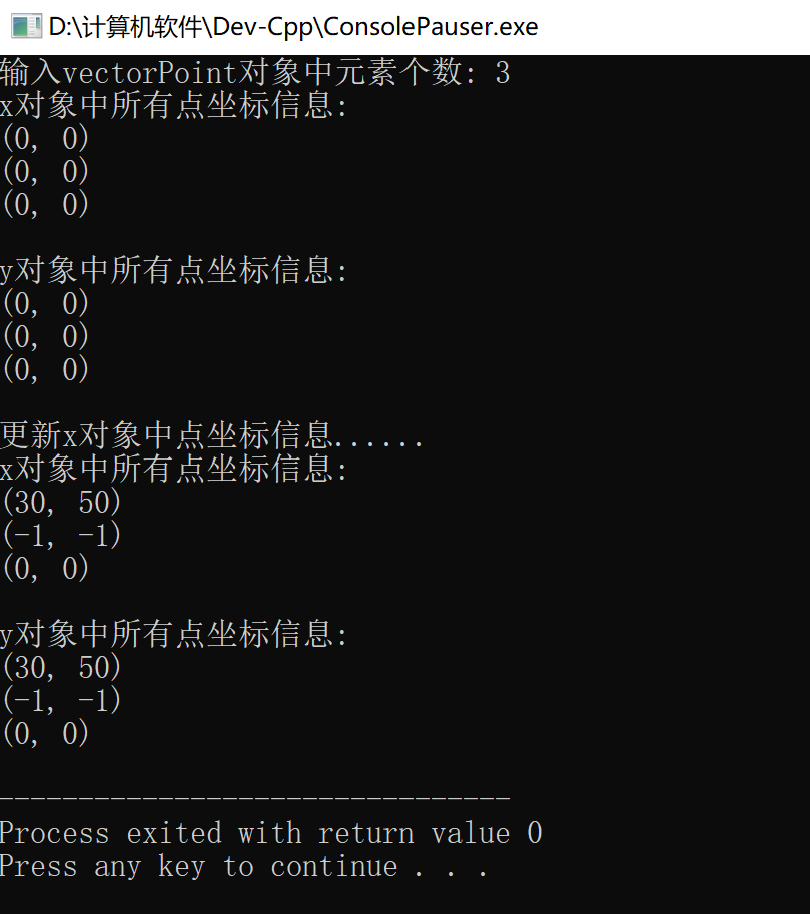
#pragma once
#include <iostream>
using std::cout;
using std::endl;
class Point {
public:
Point(int x0 = 0, int y0 = 0);
~Point() = default;
int get_x() const;
int get_y() const;
void show() const;
void move(int new_x, int new_y);
private:
int x, y;
};
Point::Point(int x0, int y0): x{x0}, y{y0} {
}
int Point::get_x() const {
return x;
}
int Point::get_y() const {
return y;
}
void Point::show() const {
cout << "(" << x << ", " << y << ")" << endl;
}
void Point::move(int new_x, int new_y) {
x = new_x;
y = new_y;
}
#pragma once
#include "point.hpp"
#include <cassert>
#include <iostream>
class vectorPoint{
public:
vectorPoint(int n);
vectorPoint(const vectorPoint &vp);
~vectorPoint();
int get_size() const; // 获得当前动态数组内元素个数
Point& at(int index); // 返回下标为index的元素引用
Point& at(int index) const; // 返回下标为index的元素const引用
private:
int size; // 动态数组的大小
Point *ptr;
};
vectorPoint::vectorPoint(int n) : size{n} {
ptr = new Point[n];
}
vectorPoint::vectorPoint(const vectorPoint &vp): size{vp.size}, ptr{new
Point[size]} {
for(auto i = 0; i < size; ++i)
ptr[i] = vp.ptr[i];
}
vectorPoint::~vectorPoint() {
delete[] ptr;
}
int vectorPoint::get_size() const {
return size;
}
Point& vectorPoint::at(int index) {
assert(index >= 0 && index < size); // 宏,在测试模式下工作。如果不满足条件,则程序终止
return ptr[index];
}
Point& vectorPoint::at(int index) const {
assert(index >= 0 && index < size);
return ptr[index];
}
#include "vectorPoint.hpp"
#include <iostream>
// 输出vectorPoint对象内的所有数据
void output(const vectorPoint &v) {
for(auto i = 0; i < v.get_size(); ++i)
v.at(i).show();
}
// 测试vectorPoint类:构造对象、复制构造对象
void test() {
using namespace std;
int n;
cout << "输入vectorPoint对象中元素个数: ";
cin >> n;
vectorPoint x(n);
cout << "x对象中所有点坐标信息: " << endl;
output(x);
vectorPoint y(x);
cout << "\ny对象中所有点坐标信息: " << endl;
output(y);
cout << "\n更新x对象中点坐标信息......" << endl;
x.at(0).move(30, 50);
x.at(1).move(-1, -1);
cout << "x对象中所有点坐标信息: " << endl;
output(x);
cout << "\ny对象中所有点坐标信息: " << endl;
output(y);
}
int main() {
test();
}
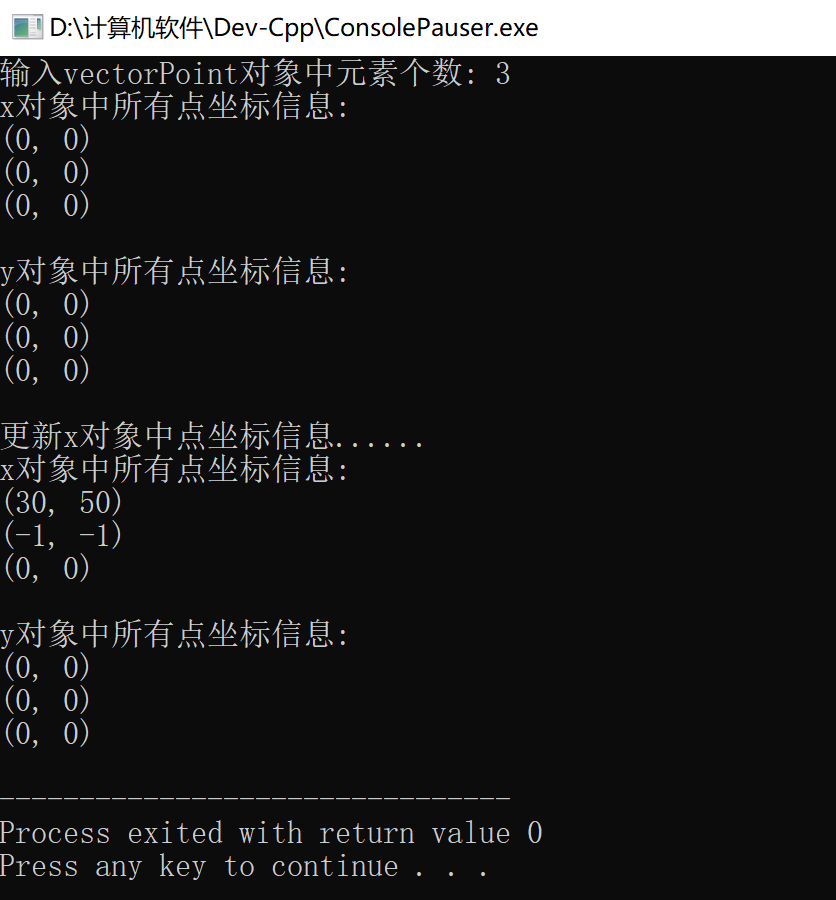
#include <iostream>
using namespace std;
// 函数声明
void swap1(int &rx, int &ry); // 引用作为形参
void swap2(int *px, int *py); // 指针作为形参
void print(int x, int y); // 普通变量作为形参
// 测试代码
void test() {
int x = 3, y = 4;
print(x, y);
swap1(x, y); // 函数调用,注意:引用作为形参时,实参形式
print(x, y);
cout << endl;
x = 3, y = 4;
print(x, y);
swap2(&x, &y); // 函数调用,注意:指针作为形参时,实参形式
print(x, y);
}
int main() {
test();
}
// 函数定义:交换两个变量(引用变量作为形参)
void swap1(int &rx, int &ry) {
int t;
t = rx; rx = ry; ry = t;
}
// 函数定义:交换两个变量(指针变量作为形参)
void swap2(int *px, int *py) {
int t;
t = *px; *px = *py; *py = t;
}
// 函数定义:输出两个变量(普通变量作为形参)
void print(int x, int y) {
std::cout << "x = " << x << ", y = " << y << "\n";
}
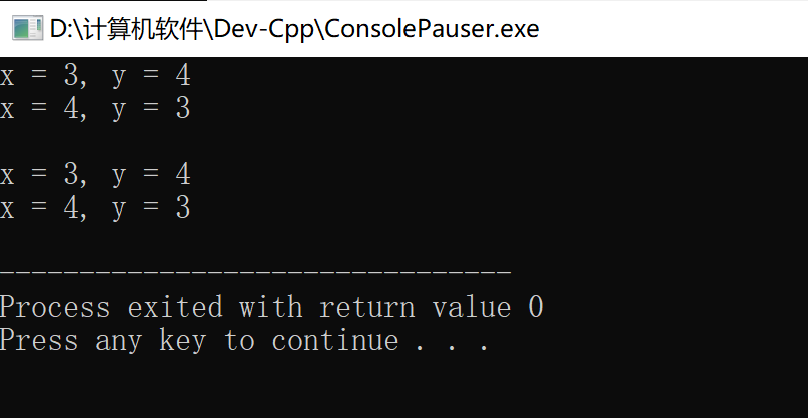
#include <iostream>
#include <typeinfo>
using namespace std;
int main() {
int a;
int &ra = a;
ra = 4;
int *pa = &a;
*pa = 5;
// 以十六进制形式输出普通变量a, 引用变量ra,指针变量pa的地址
cout << "&a = " << hex << &a << endl;
cout << "&ra = " << hex << &ra << endl;
cout << "&pa = " << hex << &pa << "\n\n";
// 输出普通变量a, 引用变量ra,指针变量pa的值
cout << "a = " << a << endl;
cout << "ra = " << a << endl;
cout << "pa = " << hex << pa << endl;
// 输出指针变量pa指向的变量的值
cout << "*pa = " << *pa << "\n\n";
// 输出普通变量a,引用变量ra, 指针变量pa的类型信息
cout << "type a: " << typeid(a).name() << endl;
cout << "type ra: " << typeid(ra).name() << endl;
cout << "type pa: " << typeid(pa).name() << endl;
}

#include <iostream>
#include <vector>
using namespace std;
template<typename T>
void output(const T &x) {
for(auto i: x)
std::cout << i << ", ";
std::cout << "\b\b \n";
}
template<typename T>
void square1(T &x) {
for(auto i: x) // i是普通类型
i *= i;
}
template<typename T>
void square2(T &x) {
for(auto &i: x) // i是引用类型
i *= i;
}
void test1() {
vector<int> x {1, 2, 3, 4, 5};
cout << "动态int型数组对象x内的元素值: ";
output(x);
cout << "调用函数square1()......" << endl;
square1(x);
cout << "动态int型数组对象x内的元素值: ";
output(x);
}
void test2() {
vector<int> x {1, 2, 3, 4, 5};
cout << "动态int型数组对象x内的元素值: ";
output(x);
cout << "调用函数square2()......" << endl;
square2(x);
cout << "动态int型数组对象x内的元素值: ";
output(x);
}
int main() {
cout << "测试1: " << endl;
test1();
cout << "\n测试2: " << endl;
test2();
}
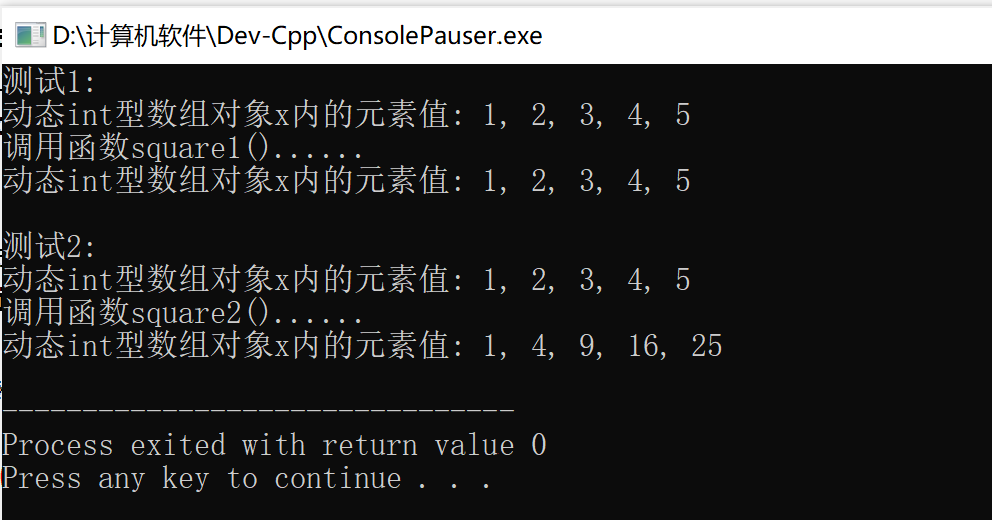
#pragma once
#include<cassert>
#include<iostream>
class vectorInt{
public:
vectorInt(int n);
vectorInt(int n,int value);
vectorInt(const vectorInt &vp);
~vectorInt();
int get_size()const;
int& at(int index);
int& at(int index)const;
void show()const;
private:
int size;
int* ptr;
};
vectorInt::vectorInt(int n):size{n}{
ptr=new int[n];
std::cout << "constructor vectorInt(int n) called. \n";
}
vectorInt::vectorInt(int n,int value):size{n}{
ptr=new int[n];
for(int i=0;i<n;i++)
{
ptr[i]=value;
}
std::cout << "constructor vectorInt(int n, int value) called. \n";
}
vectorInt::vectorInt(const vectorInt &vp):size{vp.size},ptr{new int[size]}
{
for(auto i = 0; i < size; ++i)
ptr[i] = vp.ptr[i];
std::cout << "copy constructor called. \n";
}
vectorInt::~vectorInt() {
delete[] ptr;
std::cout << "destructor called" << std::endl;
}
int vectorInt::get_size() const {
return size;
}
int& vectorInt::at(int index)
{
return ptr[index];
}
int& vectorInt::at(int index)const
{
return ptr[index];
}
#include "vectorInt.hpp"
#include <iostream>
using std::cout;
using std::cin;
using std::endl;
// 函数output()的定义:遍历输出vectorInt对象内的所有元素
void output(const vectorInt &vi) {
for(auto i = 0; i < vi.get_size(); ++i)
cout<<vi.at(i)<<", ";
cout<<"\b\b\n";
}
void test() {
int n;
cout << "输入vectorInt对象中元素个数: ";
cin >> n;
vectorInt x1(n); // 构造动态int数组对象x1,包含n个元素,不对元素初始化
for(auto i = 0; i < n; ++i)
x1.at(i) = i*i;
cout << "vectorInt对象x1: ";
output(x1);
vectorInt x2(n, 42); // 构造动态int数组对象x1,包含n个元素,每个元素初始值为42
cout << "vectorInt对象x2: ";
output(x2);
vectorInt x3(x2); // 使用x2构造x3
cout << "vectorInt对象x3: ";
output(x3);
cout << "更新vectorInt对象x2......\n";
x2.at(0) = 77;
x2.at(1) = -999;
cout << "vectorInt对象x2: ";
output(x2);
cout << "vectorInt对象x3: ";
output(x3);
}
int main() {
test();
}

#pragma once
#include <iostream>
#include <cassert>
using std::cout;
using std::endl;
// 类Matrix的声明
class Matrix {
public:
Matrix(int n, int m); // 构造函数,构造一个n*m的矩阵
Matrix(int n); // 构造函数,构造一个n*n的矩阵
Matrix(const Matrix &x); // 复制构造函数, 使用已有的矩阵X构造
~Matrix();
void set(const double *pvalue); // 用pvalue指向的连续内存块数据按行为矩阵赋值
void set(int i, int j, double value); // 设置矩阵对象索引(i,j)的元素值为value
double& at(int i, int j) const; // 返回矩阵对象索引(i,j)的元素引用
double& at(int i, int j); // 返回矩阵对象索引(i,j)的元素引用
int get_lines() const; // 返回矩阵对象行数
int get_cols() const; // 返回矩阵对象列数
void print() const; // 按行打印输出矩阵对象元素值
private:
int lines; // 矩阵对象内元素行数
int cols; // 矩阵对象内元素列数
double *ptr;
};
Matrix::Matrix(int n, int m):lines{n},cols{m}
{
ptr=new double[n*m];
}
Matrix::Matrix(int n):lines{n},cols{n}{
ptr=new double[n*n];
}
Matrix::Matrix(const Matrix &x):lines{x.lines},cols{x.cols}
{
ptr=new double[x.lines*x.cols];
for(int i=0;i<lines*cols;i++)
{
ptr[i]=x.ptr[i];
}
}
Matrix::~Matrix()
{
delete[] ptr;
}
void Matrix::set(const double *pvalue)
{
for(int i=0,j=0;i<lines*cols;i++,j++)
{
ptr[i]=pvalue[j];
}
}
void Matrix::set(int i, int j, double value)
{
ptr[i*lines+j]=value;
}
double& Matrix::at(int i, int j) const
{
return ptr[i*lines+j];
}
double& Matrix::at(int i, int j)
{
return ptr[i*lines+j];
}
int Matrix::get_lines() const
{
return lines;
}
int Matrix::get_cols() const {
return cols;
}
void Matrix::print() const
{
for(int i=0;i<lines;i++)
{
for(int j=0;j<cols;j++)
{
cout<<ptr[i*cols+j]<<", ";
}
cout<<"\b\b \n";
}
}
#include <iostream>
#include "matrix.hpp"
using namespace std;
const int N1 = 3;
const int N2 = 2;
// 输出一个矩阵对象中索引为index对应的行的所有元素值
void output(const Matrix &m, int index) {
for(auto j = 0; j < m.get_cols(); ++j)
cout << m.at(index, j) << ", ";
cout << "\b\b \n";
}
void test() {
double x[N1*N2] = {1, 2, 3, 4, 5, 6};
Matrix m1(N1, N2); // 创建一个N1×N2矩阵
m1.set(x); // 用一维数组x的值按行为矩阵m1赋值
cout << "矩阵对象m1: " << endl;
m1.print(); // 打印矩阵m1的值
cout << "矩阵对象m1第0行是: " << endl;
output(m1, 0);
cout << endl;
Matrix m2(N2, N1);
m2.set(x);
cout << "矩阵对象m2: " << endl;
m2.print();
cout << "矩阵对象m2第0行是: " << endl;
output(m2, 0);
cout << endl;
Matrix m3(m2); // 用矩阵m2构造新的矩阵m3
m3.set(0, 0, 999); // 讲矩阵对象m2索引(0,0)元素设为999
cout << "矩阵对象m3:" << endl;
m3.print();
cout << endl;
Matrix m4(2); // 创建一个2*2矩阵对象
m4.set(x); // 用一维数组x的值按行为矩阵m4赋值
cout << "矩阵对象m4:" << endl;
m4.print();
}
int main() {
test();
}
